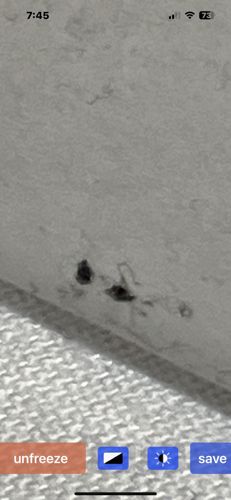Cockroach (likely American or German Cockroach based on typical indoor appearance)
Scientific Name: Periplaneta americana (American Cockroach) or Blattella germanica (German Cockroach) - definite species identification requires clearer image details.
Order & Family: Blattodea, Blaberidae (for American Cockroach) or Ectobiidae (for German Cockroach)
Size: Common pest species like the German Cockroach are typically 1.1-1.6 cm (0.43-0.63 in) long, while the American Cockroach is larger, ranging from 3.5-5.3 cm (1.4-2.1 in) long.

Natural Habitat
Warm, humid, and dark environments, often close to food and water sources. Indoors, they are commonly found in kitchens, bathrooms, basements, utility pipes, under sinks, behind appliances, in wall voids, and near drains. Outdoors, they can be found in sewers, drains, dumpsters, and decaying organic matter.
Diet & Feeding
Omnivorous scavengers; they will eat almost anything organic, including food scraps, decaying matter, pet food, glue, hair, soap, and even other cockroaches. They are particularly attracted to starches, sweets, grease, and meat products.
Behavior Patterns
Cockroaches are primarily nocturnal and gregarious, preferring to hide in dark, hidden crevices during the day. They are fast runners and can exhibit quick evasive maneuvers when disturbed. They are known for their ability to reproduce rapidly, with females producing multiple egg cases (oothecae) throughout their lifespan. They can spread quickly within an infested area and to new locations. Some species can fly, though many prefer to run. They often groom themselves to remove debris and dirt.
Risks & Benefits
Risks: Cockroaches can carry and transmit various pathogens, including bacteria (e.g., Salmonella, E. coli), viruses, fungi, and parasitic worms, from contaminated areas to food preparation surfaces and food, potentially causing food poisoning and other illnesses. Their droppings and shed skins can trigger allergies and asthma attacks, especially in children and individuals with respiratory sensitivities. They can contaminate food and surfaces, produce unpleasant odors, and are generally considered a nuisance pest impacting hygiene and quality of life. Benefits: In certain ecosystems, some species may play a role in decomposition, breaking down organic matter. However, their role in human-dominated environments is overwhelmingly negative.
Identified on: 8/28/2025